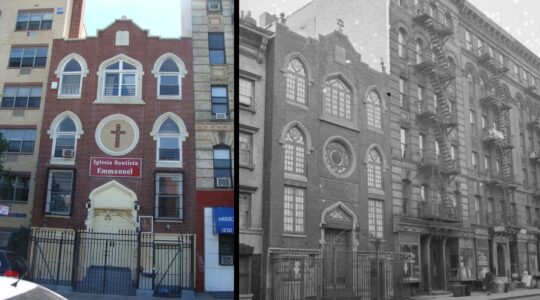NEW YORK — Once upon a time in Colmar, France, a group of workmen renovating a confectionary shop on the Rue des Juifs chanced upon a cache of jewels and coins belonging to a medieval Jewish family. Only this was no fairy tale — what the workmen discovered inside the crumbling wall on that day in 1863 was the true story of a legacy left behind in the wake of persecution.
As the Bubonic Plague swept over Europe in 1348, a Jewish family in Colmar hid a small trove of jewelry, including garnet, turquoise and emerald rings, within the walls of their house. This cache came to be known as the Colmar Treasure and is now on display at the Met Cloisters, the medieval-focused branch of the Metropolitan Museum of Art in New York.
On loan from the Musée de Cluny in Paris, the exhibit’s significance comes not from its size, but from how it represents Judaism in a space usually devoted to Christian art and artifacts. The museum’s design incorporates five medieval cloisters, and crucifixes and Christian-themed tapestries, including the famed unicorn tapestries, are on display in the galleries above and adjacent to the Colmar Treasure.
Juxtaposed with the other displays, the exhibit is a reminder of Jewish artistic heritage, as well as the perils Jewish minority communities faced then and now.
“I think the power of this material is its personal nature. It’s appropriately deemed a treasure, not because of the nature of the gold or the size of the gems, but because it’s an unexpected testament to lives lived and lost. Its poignancy is because of its personal scale,” said Dr. Barbara Drake Boehm, the Paul and Jill Ruddock Senior Curator, Department of Medieval Art and The Cloisters.
A Jewish presence was first documented in Colmar, a storybook city in the Holy Roman Empire, in the 13th century. Over time, the community, bolstered by the local wine industry, built a synagogue, a school and a mikveh, or ritual bath. Jews owned property, houses and businesses. Among the recorded Jewish residents lived a rabbi, a Jewish doctor and several prosperous merchants. The community was growing and beginning to thrive.
That growth is mirrored in the exhibit, Boehm said.
“We can see quite clearly the family’s life was improving over the years. Just look at the rings. One of the earliest ones is a gilded silver ring with a glass stone. Only later come the gems. This suggests the family was feeling confident about their place in the city,” she said.
For decades the Jewish people lived alongside their Christian neighbors–until 1348 when the plague struck. Soon, townspeople all along the Rhine accused Jews of poisoning the wells and, ignoring the pope’s pleas to display mercy, burned their Jewish citizens to death. It is theorized that the family that hid the Colmar Treasure was likewise murdered.
Historians estimate that over half of the Jewish population of the Holy Roman Empire perished between 1348 and 1351, either from the plague or persecution. In a few short years all signs of the Jewish community were erased; after the massacre, Jewish assets were seized. Nevertheless, these precious objects belonging to a single Jewish family, whose name remains unknown, allows a peek into Jewish medieval life.
Historians estimate that over half of the Jewish population of the Holy Roman Empire perished between 1348 and 1351, either from the plague or persecution
“This is no ordinary treasure. The word implies a certain ‘bling,’ an evident ostentation; Colmar’s treasure is unpretentious. ‘Treasure’ conjures up a romantic past; Colmar’s treasure is tinged with tragedy,” wrote Elisabeth Taburet-Delahay, director of the Musée Cluny, in a forward to the exhibit’s catalogue.
One of the exhibit highlights is an intricately crafted ceremonial wedding ring, inscribed with the words “mazal tov,” Hebrew for “congratulations.” Crafted from gold and enamel, it resembles the lost Solomon’s Temple in Jerusalem.
There is also an onyx ring with the Latin inscription “avdi, vidi,” or “I heard, I see.” The words suggest a connection to the onetime Jewish superstition that onyx allowed people to communicate with their dead loved ones through dreams.
Also on display is a miniature key fashioned from silver. Normally, silver was deemed too soft and too valuable to use for something so functional. However, since the key was silver it could be considered jewelry. As the Sabbath neared, the lady of the house could use the silver key to secure the household’s other keys in a single box and then wear it as a pendant without violating the Sabbath restriction against carrying objects outside the home.
Additionally, among the 384 silver coins dating from 1180 to the 1340s there is a single gold florin. Wealthy Jews were required to give the Holy Roman Emperor Charles IV one gold florin a year.
The exhibit, which runs through January 12, 2020, is being shown alongside related works and artifacts from The Cloisters Collection, The Jewish Theological Seminary, the Bibliothèque municipal in Colmar and private collections in the United States.
One such artifact is an illuminated Hebrew Bible on loan from the Jay and Jeanie Schottenstein Family Collection of Rare Judaica.
These artifacts give the Colmar Treasure context. That’s no easy feat because, as Taburet-Delahay wrote, it’s not easy to do justice when showcasing the cultural heritage of the medieval Jewish population.
Boehm, a medievalist who works in the Cloisters, seconded that notion.
“It can be easy to overlook the vital role Jewish communities in Europe played at the time. This exhibit attests to Jewish lives, not only their deaths. It allows their lives to be appropriately honored,” she said.
The New York Jewish Week brings you the stories behind the headlines, keeping you connected to Jewish life in New York. Help sustain the reporting you trust by donating today.




